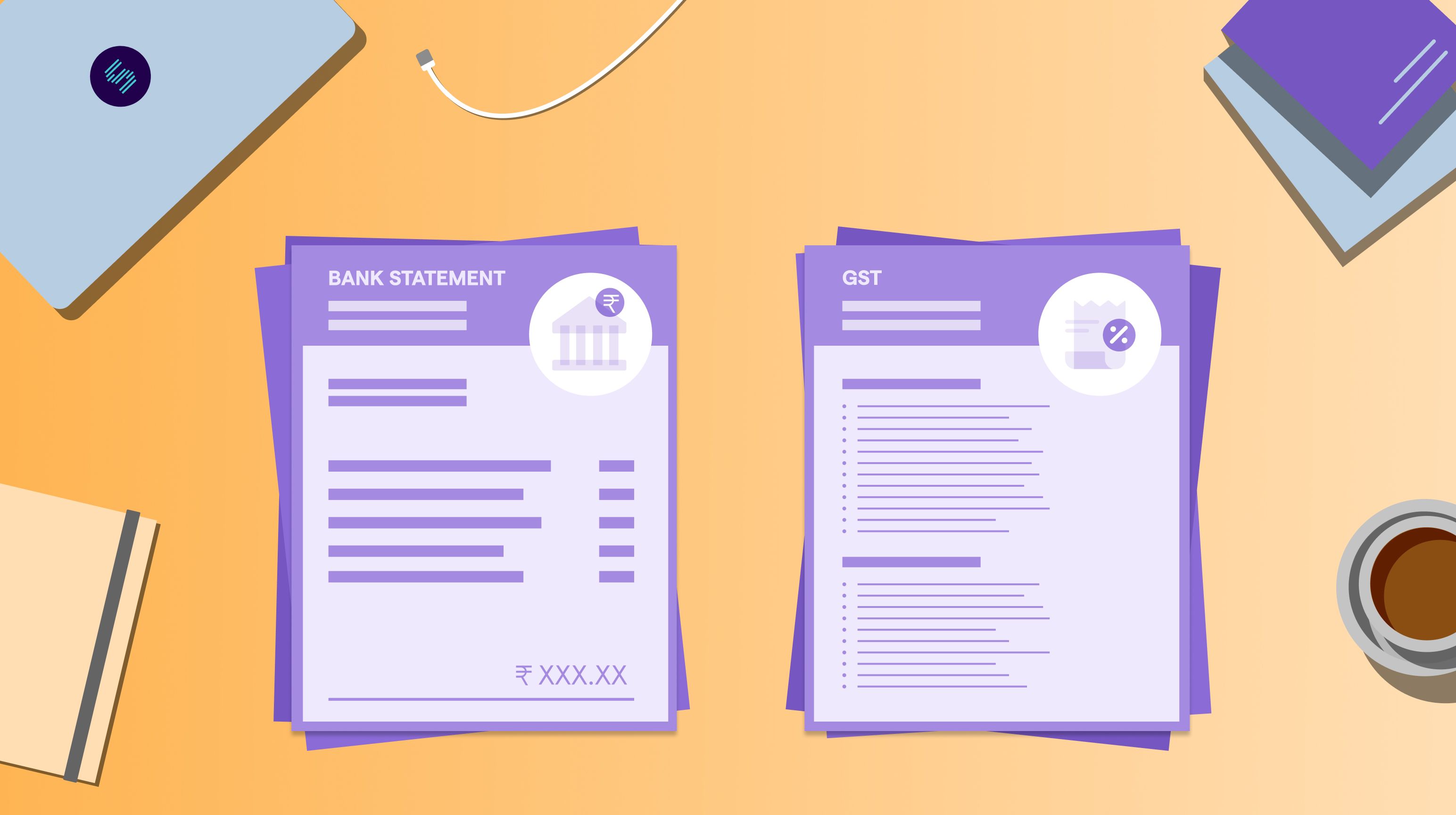
The story of India’s Account Aggregator (AA) journey took an interesting turn when GSTN data went live on the framework.
Until then, the AA framework had data on only the entities that were governed by one of the four Financial Services Regulators (FSRs) in India. The addition of GST through The Department of Revenue wasn’t just a new chapter; it was an entire year-long saga, bringing the crucial GST data into the AA fold.
The 4 financial regulators are RBI, SEBI, IRDAI, and PFRDA. Check out this article to learn more about licenses that are relevant for AA and the process to obtain them.
A new dawn for B2B lenders
For lenders, SMB bank statements have long been the primary path to underwriting and offering credit. But with this new addition, was another gold mine—tax data. A true reflection of the ebb and flow of an SMB’s financial currents.
Prior to GSTN being available on AA, lenders had to ask SMB borrowers to provide copies of their GST returns, which helps them with an insight into the business's monthly sales, purchases, and the tax paid. They also had to provide this as a separate flow with its own OTPs and everytime it's was shared, it needed an authentication. Now, with AA it can be shared periodically/onetime through a single consent along with other accounts.
Some tech-savvy lending platforms have also integrated their systems with GST portals. With the borrower's consent, these platforms can fetch GST data directly, making the verification process a bit faster. However, there were several teething issues with these processes—low accuracy and poor user experience were some of them.
With GSTN now live on AA as an FIP, lenders have been handed a more detailed map to underwrite, illuminating paths previously obscured. No longer do they have to depend solely on bank statements. The comprehensive insight from GST 3B data, combined with the nuggets from Table 4 of GST 1, offers a richer, fuller picture of an SMB’s financial history.
GST 3B provides a comprehensive summary of a business’s taxable supplies. This not only gives you an understanding of business health but also enables you to match cash inflows and outflows from a bank statement with actual revenue and costs as per GST records. It details the Input Tax Credit availed, taxes payable and paid, and any late fee details for delayed filing. While GSTR 1 Table 4 gives monthly and quarterly statements of all Outward Supplies. For lenders, this data is pivotal for assessing a business's financial health.
Cash flow-based lending is no longer a distant reality.

Sign up with Setu here to get started
Here’s a sample GST response file on AA
<Accountxmlns="http://api.rebit.org.in/FISchema/gstr1_3b"xmlns:vc="http://www.w3.org/2007/XMLSchema-versioning"xmlns:xsi="http://www.w3.org/2001/XMLSchema-instance" xsi:schemaLocation="http://api.rebit.org.in/FISchema/gstr1_3b../FISchema/gstr1_3b.xsd" maskedGstinNumber="24XXXXXXXXXX1ZT" version="1.0.0" linkedAccRef="LRN2414230723000005" type="gstr1_3b"><Profile><BusinessDetails lgnm="Powerhouse Productions Pvt Ltd" apprvdt="2021-01-01" iscmp="R" dty="TP" sts="A" trdnm="GSTN"><CategoryList/></BusinessDetails><PlaceofBusiness><Address bno="252" bnm="Gold Hill Supreme" st="Shantipura Cross Roads" loc="Electronic City Phase 2" stcd="24" dst="Ahmedabad" pncd="360123"><NatureOfBusinessList><ntr>Export</ntr></NatureOfBusinessList></Address></PlaceofBusiness></Profile><Transactions strdt="2020-11-01" endt="2023-04-30"><Gstr1Details><gstr1 ret_prd="012021" dof="2023-04-26" status="FIL" filingFrequency="MONTHLY"><b2b_dtls><b2b inum="567" idt="31-01-2021" val="3000.0" pos="23" rchrg="N" diff_percent="1.0" inv_typ="R" ctin="XXXXXXXXXXXXXXX"><itm_det><itm txval="1900.0" iamt="19.0"/></itm_det></b2b></b2b_dtls></gstr1><gstr1 ret_prd="022021" dof="2023-07-26" status="FIL" filingFrequency="MONTHLY"><b2b_dtls/></gstr1></Gstr1Details><Gstr3bDetails><gstr3b ret_prd="012021" dof="2023-04-26" status="FIL" filingFrequency="MONTHLY"><sup_details><osup_det txval="4900.0" iamt="19.0" camt="0.0" samt="0.0" csamt="0.0"/><osup_zero txval="2000.0" iamt="30.0" camt="0.0" samt="0.0" csamt="0.0"/><osup_nil_exmp txval="0.0" iamt="0.0" camt="0.0" samt="0.0" csamt="0.0"/><isup_rev txval="0.0" iamt="0.0" camt="0.0" samt="0.0" csamt="0.0"/><osup_nongst txval="0.0" iamt="0.0" camt="0.0" samt="0.0" csamt="0.0"/></sup_details><intr_ltfee><intr_details iamt="0.0" camt="0.0" samt="0.0" csamt="0.0"/><ltfee_details iamt="0.0" camt="0.0" samt="0.0" csamt="0.0"/></intr_ltfee><itc_elg/><inward_sup/><tx_pmt><tx_py_list><tx_py tran_desc="Other than Reverse Charge"><igst tx="0.0" intr="0.0" fee="0.0"/><cgst tx="0.0" intr="0.0" fee="0.0"/><sgst tx="0.0" intr="0.0" fee="0.0"/><cess tx="0.0" intr="0.0" fee="0.0"/></tx_py><tx_py tran_desc="Reverse Charge"><igst tx="0.0" intr="0.0" fee="0.0"/><cgst tx="0.0" intr="0.0" fee="0.0"/><sgst tx="0.0" intr="0.0" fee="0.0"/><cess tx="0.0" intr="0.0" fee="0.0"/></tx_py></tx_py_list></tx_pmt><pdcash_dtls><pditc/><pdcash_list><pdcash ipd="49.0" cpd="0.0" spd="0.0" cspd="0.0" i_intrpd="0.0" c_intrpd="0.0" s_intrpd="0.0" cs_intrpd="0.0" c_lfeepd="0.0" s_lfeepd="0.0" trans_desc="30002"/></pdcash_list></pdcash_dtls><eco_dtls/><sup_inter><unreg_details_list/><comp_details_list/><uin_details_list/></sup_inter></gstr3b></Gstr3bDetails></Transactions></Account>
This XML data response is the GST (Goods and Services Tax) returns, specifically GSTR-1 and GSTR-3B. While this is the raw file, let’s break down the main output fields.
- Profile information:
- BusinessDetails: Contains details about the business.
- lgnm: Legal name of the business.
- apprvdt: Approval date.
- iscmp: Indicates if the entity is a company.
- dty: Duty type.
- sts: Status of the business.
- trdnm: Trade name under GST.
- PlaceofBusiness: Contains the address and nature of the business.
- Address: Business address details.
- NatureOfBusinessList: Nature of the business, e.g., Export.
- Transactions:
- Gstr1Details: Contains details related to GSTR-1 return.
- b2b_dtls: B2B transaction details.
- inum: Invoice number.
- idt: Invoice date.
- val: Invoice value.
- pos: Place of supply.
- rchrg: Indicates if it's a reverse charge.
- inv_typ: Invoice type.
- ctin: Counterparty's GSTIN.
- itm_det: Item details, including taxable value and integrated tax amount.
- Gstr3bDetails: Contains details related to GSTR-3B return.
- sup_details: Supply details, including taxable value and tax amounts.
- intr_ltfee: Interest and late fee details.
- itc_elg: Input tax credit eligibility details.
- inward_sup: Inward supply details.
- tx_pmt: Tax payment details.
- pdcash_dtls: Paid cash details.
The GST data available on AA provides a comprehensive view of an SMB’s profile, financial activities, compliance, and operational health. B2B lenders can use this data to assess the creditworthiness of a business, determine loan amounts, and set interest rates. You can check out this article where we do a detailed breakdown of each line item in the GST data response.
Okay now, let’s get back.
Empowering SMEs through credit
At the heart of the Indian economic narrative are its SMBs.
Recognising this, the quest was clear: How could Account Aggregator be the wind beneath SMEs, ensuring they soar with easy credit availability?
Before GST’s incorporation, AA was like a grand library. Vast, but with an exclusive membership of sole proprietorship SMBs. SMBs registered as Private Limited companies, LLPs, or Partnerships stood outside. Simply because the current schema for Current Account data (FI) does not have a provision to fetch data for non-sole proprietor accounts. More importantly, it's hard to determine an SMB’s revenues solely on the bank data. GST is a clear sign of formalized revenues and expenses. Additionally, It also helps combat fraud and manipulation of bank balances and revenues
With GST data now adorning AA’s shelves, the doors for SME lending have flung wide open and these SMBs can now be served through the AA framework.
These SMBs are no longer mere spectators; they will be active participants in India’s SME lending journey.
If we want to go deeper into problems faced by MSMEs and why gst is a game changer via AA, check out this article.
A journey of collaboration
Behind this moment is an eventful journey marked by foresight, collaboration, and unwavering determination. It began with a dream, envisioned by market participants, and given shape with the help of Sahamati. Their proposal wasn't just a document; but a beacon, highlighting the horizon of possibilities that GST data could bring to AA.
The narrative took this proposal on a voyage. From the desks of the GSTN team to the Department of Revenue, each chapter added more depth and clarity. The climax? The Reserve Bank of India, entrusting ReBIT with the task of evaluation. As the curtains drew, the GST Schema made its debut on AA, marking the culmination of a journey that took over a year.
On behalf of the fintech world, we’d like to extend our gratitude to Shri Manish Kumar Sinha (CEO of GSTN), Shri Sanjay Malhotra (Revenue Secretary), Shri Vivek Joshi (Secretary of Financial Services), Shri Bhushan Js (DFS), Shri Ritwik Pandey (JS DoR) and the GST Council who helped bring this vision to life.
The UPI moment for B2B lending
As our tale unfolds, the integration of GST data into AA isn’t just another subplot in India’s financial story. It has the potential to be a transformative arc that could redefine the credit evaluation landscape. It promises a world where lenders have more confidence as they go deeper into the trenches of SME lending. There is also a promise that the Central Board of Direct Taxes(CBDT) will also be an FIP on the Account Aggregator framework soon.
This tale, though told, is far from over. It’s the beginning of countless new stories, each waiting to be written, each waiting to be told. And as they unfold, they will continue to shape, define, and elevate India’s Account Aggregator journey.
And we thank our stars that we have a front-row seat to witness this.




